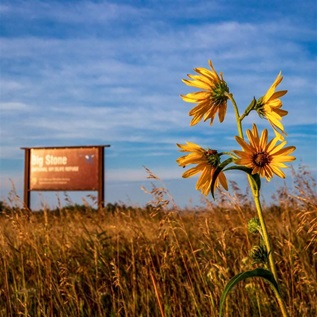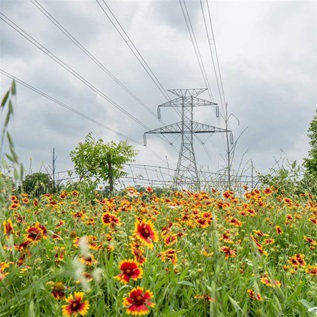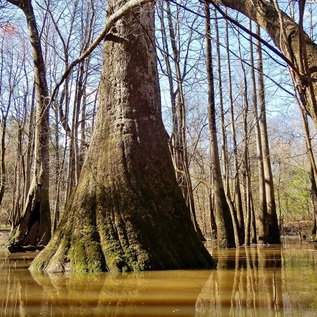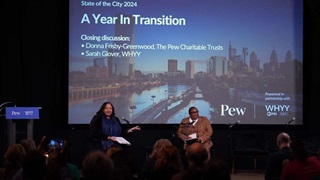Dominion Energy Offshore Wind Farm Advances the Clean Energy Economy
Power company executive discusses building support for largest such project in the nation

John Larson, director of public policy and economic development at the power company Dominion Energy Virginia, has participated in thousands of meetings talking about the Coastal Virginia Offshore Wind (CVOW) farm that the utility is building 27 miles off the coast of Virginia Beach. Dominion received federal approval in October 2023 to proceed with the project, which will be the country’s largest offshore wind farm, spanning 113,000 acres and housing 176 turbines when it becomes fully operational in 2026. Larson leads the work to advance the economic and workforce development necessary to support the project.
This interview with him has been edited for clarity and length.
Q: Construction of Dominion Energy Virginia’s much-awaited Coastal Virginia Offshore Wind farm is set to begin early next year. What makes this project so novel?
A: Well, I think a couple of key factors here come into play. I’ll start with the two pilot turbines that have been operating since October 2020. We started that project several years earlier, and it went through some iterations that caused us to come up with new approaches to get the turbines permitted and installed.
So, it’s unique because we’ve actually gone through the entire permitting and installation process, and now we have three years of operations under our belt. And frankly, we saw that no one had successfully navigated this.
Q: And then in 2025, you’ll be launching a new turbine installation vessel, Charybdis, the first of its kind in the U.S. How will that support Dominion’s offshore wind project?
A: We decided to move forward with the construction of Charybdis so that we can install turbines up and down the East Coast, not just at CVOW; the vessel will be available to other developers to charter.
Q: Can you describe the overall impact the fully completed farm will have?
A: We know that the average Dominion Energy customer uses about 1,000 kilowatts of energy per month. This facility, at almost 2,600 megawatts, can power 660,000 homes in Virginia when it’s completed in 2026. That’s almost 25% of our Virginia residential customers—pretty phenomenal if you think about carbon emissions, because obviously when the units are generating, there’ll be no fuel needed and no emissions generated. So, it’s the equivalent of taking about a million gasoline- or diesel-powered vehicles off the road annually.
Q: What’s been the reaction of visitors who come out and see the first two turbines?
A: I will tell you that the first reaction is, “Oh my gosh, you said they would be taller than the Washington Monument, but I just didn’t realize what they would look like out here!” So, just the size of them is pretty amazing. The second thing is the sound. There seems to be this impression that they’re going to sound like helicopter blades, right?—whop, whop, whop. Well, it’s a gentle swish, swish. That’s when you’re right under them. If you’re 200 yards away, you don’t even hear them.
Q: Construction of the wind farm will require dozens of skilled workers. How have Dominion Energy and the rest of the industry been working to fill these roles?
A: We took a three-pillar approach. The first one was true economic development: We’ve worked very diligently with Virginia’s Economic Development Partnership—a state agency tasked with cultivating opportunities for growth—as well as regional agencies with a similar purpose, such as Hampton Roads Alliance, and some of the area municipalities, including Virginia Beach, Portsmouth, Norfolk, Chesapeake, and Suffolk.
The second pillar is looking at supply chain development. Because of the naval presence around the Hampton Roads area, we’ve got one of the largest maritime industries in the world—and certainly one of the largest in the United States. So how do we get adjacent businesses to say, “Oh, we already make metal pieces for boats. We can make metal pieces for offshore wind turbines”?
Each turbine will have an HVAC unit in it. So, we need people to go out there and service that HVAC. We’re in a marine environment, so we’re going to need technicians to properly apply the marine coatings to the transition pieces, turbines, and towers. There are all sorts of roles that people may not traditionally think about for an offshore wind project.
About 1,000 workers in the U.S. have worked on the project; 750 of those were from Virginia, of which around 500 of them were from the Hampton Roads area. So, I feel comfortable in saying that we’re seeing the fruits of our regional outreach efforts.
Q: And the third pillar?
A: Workforce development, by which I mean working with everything from K-12 schools, community colleges, and four-year public and private colleges to really share the career opportunities that this project offers.
Q: How important is community buy-in?
A: It is tantamount to success. Between my colleagues and me, we’ve had about 500 meetings just on workforce, education, and business and another 1,500 meetings with community organizations and houses of faith. We’ve worked with diverse communities, which is critically important: the Filipino community, the Vietnamese community, other parts of the Asian American community, and the African American community. And, very critically, we’ve worked with Native American populations; there are a number of Tribes in the area.
We’ve had approximately 15 open houses since 2021 to talk to individuals who live near the transmission lines to share our plans to bring electricity to these customers’ homes. We were very fortunate that we were able to use almost 20 miles of existing transmission line right-of-way and an existing easement for future roadway development to bring this power to consumers. That infrastructure helped reduce the amount of construction—and disruption—needed to get the power from our turbines to people’s homes.
Q: Recently, the offshore wind supply chain has faced several challenges. Has your project experienced those challenges?
A: Because Dominion Energy Virginia is a regulated utility, before we went to the Virginia State Corporation Commission for approval, we had to get bids and costs for the project to share with the commission.
And what that did was make sure we had purchased our steel, and the copper for electric cable and wiring, among various other commodities. We were able to beneficially contract for the cost to get everything made and hedge the commodity risk, so we know what our costs are—and we also know that the materials are there to manufacture our components and ensure they're being delivered on time. In fact, 92% of project costs are fixed, and our suppliers are manufacturing components today, positioning CVOW to remain on schedule for completion in 2026.
Q: Are there any more large-scale offshore wind farms in Dominion’s future? I guess we're asking you to make news here.
A: I would say Dominion Energy is keenly following the Bureau of Ocean Energy Management plans to move forward with additional auction of some central Atlantic wind energy areas. We'll have to evaluate what happens as those wind energy areas come up for auction and how we might see that fitting into future projects.
Spotlight on Mental Health
MORE FROM PEW
Explore Pew’s new and improved
Fiscal 50 interactive
Your state's stats are more accessible than ever with our new and improved Fiscal 50 interactive:
- Maps, trends, and customizable charts
- 50-state rankings
- Analysis of what it all means
- Shareable graphics and downloadable data
- Proven fiscal policy strategies
Welcome to the new Fiscal 50
Key changes include:
- State pages that help you keep track of trends in your home state and provide national and regional context.
- Interactive indicator pages with highly customizable and shareable data visualizations.
- A Budget Threads feature that offers Pew’s read on the latest state fiscal news.














